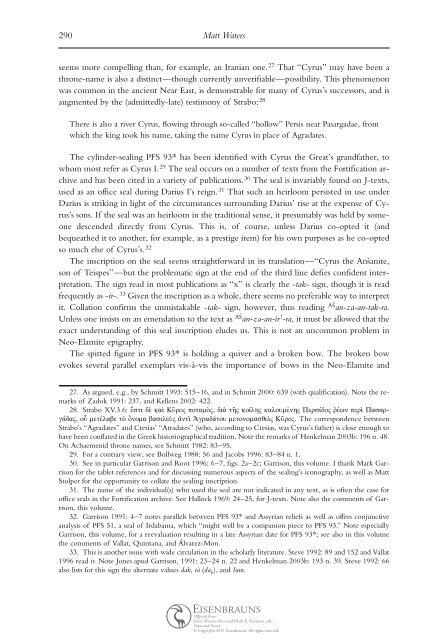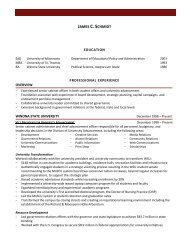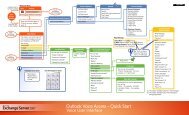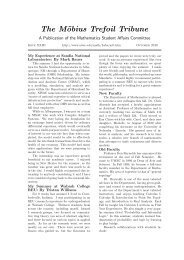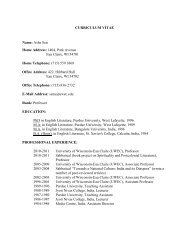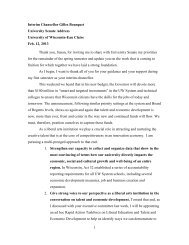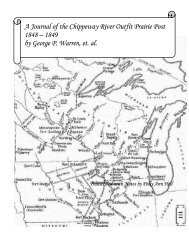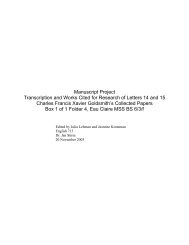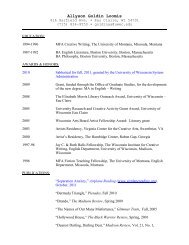Elam and Persia - University of Wisconsin-Eau Claire
Elam and Persia - University of Wisconsin-Eau Claire
Elam and Persia - University of Wisconsin-Eau Claire
You also want an ePaper? Increase the reach of your titles
YUMPU automatically turns print PDFs into web optimized ePapers that Google loves.
290<br />
Matt Waters<br />
seems more compelling than, for example, an Iranian one. 27 That “Cyrus” may have been a<br />
throne-name is also a distinct—though currently unverifiable—possibility. This phenomenon<br />
was common in the ancient Near East, is demonstrable for many <strong>of</strong> Cyrus’s successors, <strong>and</strong> is<br />
augmented by the (admittedly-late) testimony <strong>of</strong> Strabo: 28<br />
There is also a river Cyrus, flowing through so-called “hollow” Persis near Pasargadae, from<br />
which the king took his name, taking the name Cyrus in place <strong>of</strong> Agradates.<br />
The cylinder-sealing PFS 93* has been identified with Cyrus the Great’s gr<strong>and</strong>father, to<br />
whom most refer as Cyrus I. 29 The seal occurs on a number <strong>of</strong> texts from the Fortification archive<br />
<strong>and</strong> has been cited in a variety <strong>of</strong> publications. 30 The seal is invariably found on J-texts,<br />
used as an <strong>of</strong>fice seal during Darius I’s reign. 31 That such an heirloom persisted in use under<br />
Darius is striking in light <strong>of</strong> the circumstances surrounding Darius’ rise at the expense <strong>of</strong> Cyrus’s<br />
sons. If the seal was an heirloom in the traditional sense, it presumably was held by someone<br />
descended directly from Cyrus. This is, <strong>of</strong> course, unless Darius co-opted it (<strong>and</strong><br />
bequeathed it to another, for example, as a prestige item) for his own purposes as he co-opted<br />
so much else <strong>of</strong> Cyrus’s. 32<br />
The inscription on the seal seems straightforward in its translation—“Cyrus the Ansanite,<br />
son <strong>of</strong> Teispes”—but the problematic sign at the end <strong>of</strong> the third line defies confident interpretation.<br />
The sign read in most publications as “x” is clearly the -tak- sign, though it is read<br />
frequently as -ir-. 33 Given the inscription as a whole, there seems no preferable way to interpret<br />
it. Collation confirms the unmistakable -tak- sign, however, thus reading AS an-za-an-tak-ra.<br />
Unless one insists on an emendation to the text as AS an-za-an-ir ! -ra, it must be allowed that the<br />
exact underst<strong>and</strong>ing <strong>of</strong> this seal inscription eludes us. This is not an uncommon problem in<br />
Neo-<strong>Elam</strong>ite epigraphy.<br />
The spitted figure in PFS 93* is holding a quiver <strong>and</strong> a broken bow. The broken bow<br />
evokes several parallel exemplars vis-à-vis the importance <strong>of</strong> bows in the Neo-<strong>Elam</strong>ite <strong>and</strong><br />
27. As argued, e.g., by Schmitt 1993: 515–16, <strong>and</strong> in Schmitt 2000: 639 (with qualification). Note the remarks<br />
<strong>of</strong> Zadok 1991: 237, <strong>and</strong> Kellens 2002: 422.<br />
28. Strabo XV.3.6: eßsti de; kaμ KuÅroÍ potamo;Í, dia; thÅÍ koÇlhÍ kaloumevnhÍ PersÇdoÍ rJevwn perμ PasargavdaÍ,<br />
ou• metevlabe to; oßnoma basileu;Í ajntμ Âgradavtou metonomasqeμÍ KuÅroÍ. The correspondence between<br />
Strabo’s “Agradates” <strong>and</strong> Ctesias’ “Atradates” (who, according to Ctesias, was Cyrus’s father) is close enough to<br />
have been conflated in the Greek historiographical tradition. Note the remarks <strong>of</strong> Henkelman 2003b: 196 n. 48.<br />
On Achaemenid throne names, see Schmitt 1982: 83–95.<br />
29. For a contrary view, see Bollweg 1988: 56 <strong>and</strong> Jacobs 1996: 83–84 n. 1.<br />
30. See in particular Garrison <strong>and</strong> Root 1996: 6–7, figs. 2a–2c; Garrison, this volume. I thank Mark Garrison<br />
for the tablet references <strong>and</strong> for discussing numerous aspects <strong>of</strong> the sealing’s iconography, as well as Matt<br />
Stolper for the opportunity to collate the sealing inscription.<br />
31. The name <strong>of</strong> the individual(s) who used the seal are not indicated in any text, as is <strong>of</strong>ten the case for<br />
<strong>of</strong>fice seals in the Fortification archive. See Hallock 1969: 24–25, for J-texts. Note also the comments <strong>of</strong> Garrison,<br />
this volume.<br />
32. Garrison 1991: 4–7 notes parallels between PFS 93* <strong>and</strong> Assyrian reliefs as well as <strong>of</strong>fers conjunctive<br />
analysis <strong>of</strong> PFS 51, a seal <strong>of</strong> Irdabama, which “might well be a companion piece to PFS 93.” Note especially<br />
Garrison, this volume, for a reevaluation resulting in a late Assyrian date for PFS 93*; see also in this volume<br />
the comments <strong>of</strong> Vallat, Quintana, <strong>and</strong> Álvarez-Mon.<br />
33. This is another issue with wide circulation in the scholarly literature. Steve 1992: 89 <strong>and</strong> 152 <strong>and</strong> Vallat<br />
1996 read ir. Note Jones apud Garrison, 1991: 23–24 n. 22 <strong>and</strong> Henkelman 2003b: 193 n. 39. Steve 1992: 66<br />
also lists for this sign the alternate values dak, tà (da 6 ), <strong>and</strong> sum.<br />
Offprint from:<br />
Javier Álvarez-Mon <strong>and</strong> Mark B. Garrison, eds.,<br />
<strong>Elam</strong> <strong>and</strong> <strong>Persia</strong><br />
ç Copyright 2011 Eisenbrauns. All rights reserved.


